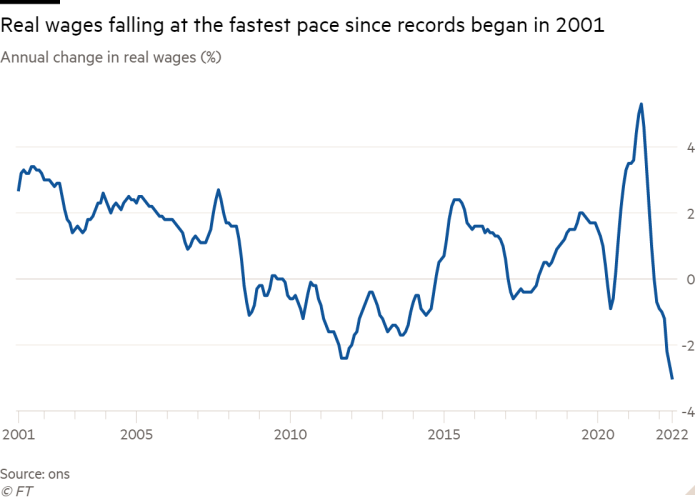Real levels of UK wages fell at the fastest rate for at least 20 years in the second quarter of this year, but the labour market remains too tight for the Bank of England to feel comfortable about inflationary pressures.
Data from the Office for National Statistics showed that in the three months to June underlying real wages fell 3 per cent, the steepest decline since comparable records began in 2001, as regular pay growth of 4.7 per cent was dwarfed by prices rising even faster.
The figures highlight the difficult financial position of households even before energy bills rise sharply in October. They also show the cost of living crisis to be much tougher for those working in the public sector, with regular pay levels rising at an annual rate of only 1.8 per cent, compared with 5.4 per cent in the private sector.
Samuel Tombs, chief UK economist at Pantheon Macroeconomics, said that despite the sharp squeeze in real wages, pay was still growing faster than the levels at which the BoE’s Monetary Policy Committee thought would bring inflation back to its 2 per cent target. It is currently at 9.4 per cent and is projected to rise to over 13 per cent early next year.
“Wage growth has more momentum than the MPC can tolerate,” Tombs said.
The wage data from the ONS came alongside broader labour market figures showing only the early signs of cooling. Unemployment was still close to 50-year lows, with historically high levels of vacancies and employment levels fairly stable.

In the second quarter, the unemployment rate crept up 0.1 percentage point to 3.8 per cent, while the employment rate fell by the same amount to 75.5 per cent.
That rate was 1 percentage point below the pre-pandemic level and left 281,000 fewer people in work than before Covid-19 struck.
The unemployment rate was only marginally higher than its 3.7 per cent level in the first quarter of the year, which was the lowest rate since the early 1970s.
With unemployment low, vacancies were still very high, showing that most people who wanted work could find it. After a small decline from a record level, there were still 1.27mn job vacancies on offer in the three months to July for the 1.29mn people who were registered as unemployed and seeking to start work immediately.
Ruth Gregory, senior UK economist at Capital Economics, said that “by any metric the labour market is still exceptionally tight” and would put pressure on the BoE to raise interest rates by another 0.5 percentage points in September.

Nye Cominetti, senior economist at the Resolution Foundation, said the real pay decline was probably worse than at any point since 1977. “This squeeze has come about despite robust pay growth and a lively jobs market, with pay settlements strengthening slightly,” he said.
Chancellor Nadhim Zahawi said the labour market data showed there were “no easy solutions” to the cost of living pressures that the country faced.
“Whilst we cannot completely shield everyone from these global economic shocks, we are targeting this support on millions of the most vulnerable people in our society: those on the lowest incomes, pensioners and disabled people,” he said in a statement.
But in a sign that pensioners are feeling increasingly vulnerable about their financial position as energy prices bite, the data showed a surge in the number of over-65s going back to work or staying in employment.
Although the state pension age rose to 66 in October 2020, there was a sudden surge of 180,000 in the number of people aged over 65 working or available to work in the second quarter alone. That was an increase of 13.6 per cent on the figures for the first quarter.


